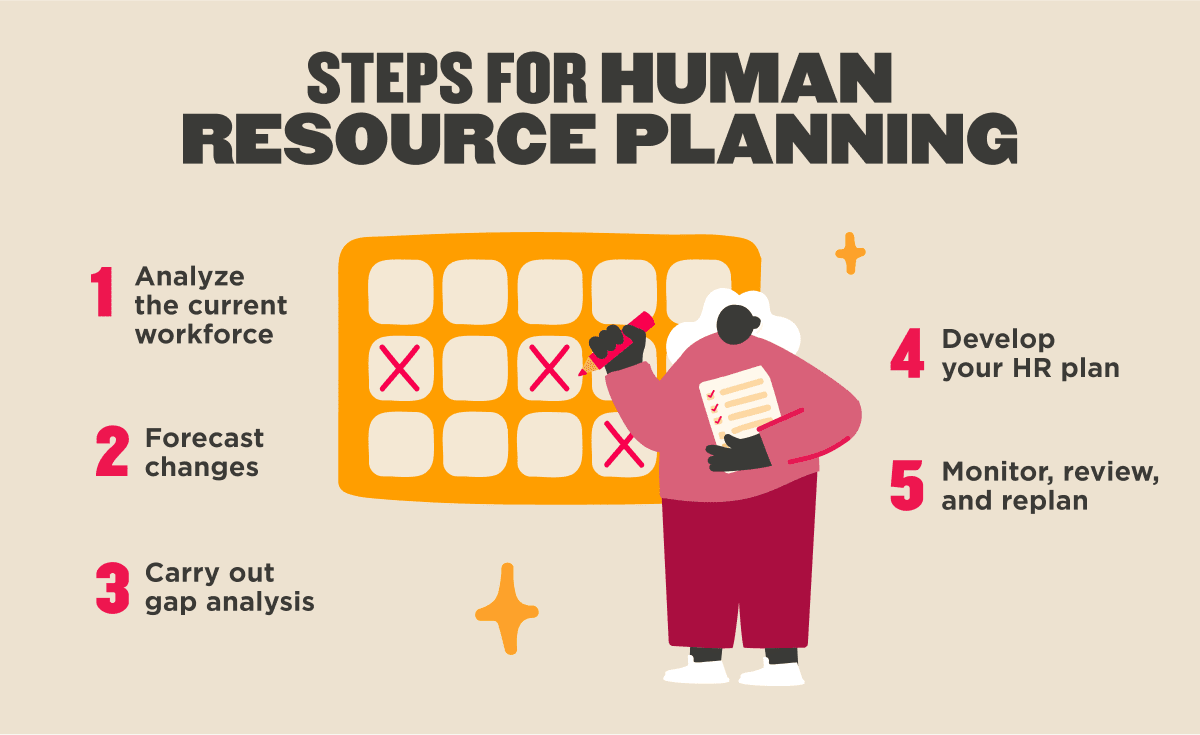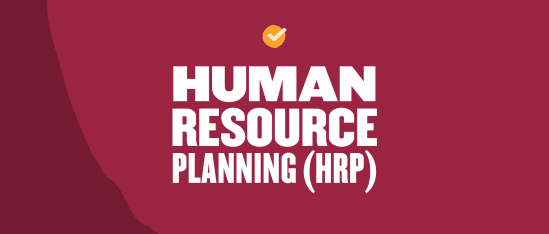The world of business is constantly changing. But one thing remains the same—the importance of human resources. After all, an organization’s success largely depends on the people behind it. But to harness the full potential of your workforce, you need a strategic approach.
That’s where human resource planning (HRP) comes into play, helping businesses prepare for the future by predicting the organization’s potential HR needs. In this blog post, we take a deeper look at what HRP means and why it’s so important to your organization’s HR strategy. We’ll also share a step-by-step walkthrough for you to effectively carry out your own HRP, as well as some commonly used tools to help you improve your HRP processes from the get-go.
<< Ensure your HR processes are up to standard with our HR audit checklist. >>
What is human resource planning (HRP)?
Human resource planning is the systematic forecasting of an organization’s future HR requirements. Ultimately, it’s to make sure the right people with the right skills are in the right places at the right times.
It’s an ongoing, data-driven process to optimize a company’s most valuable asset—its people—by avoiding shortages or surpluses. This involves identifying current and future hiring or training and development needs, addressing skill gaps, and implementing strategies for talent acquisition.
HRP is about aligning HR strategies with the evolving needs of your business to ensure optimal performance and productivity while avoiding costly workforce imbalances.
Key insights
- HRP aligns talent strategy with business goals by ensuring the right people are in the right roles at the right time
- It supports workforce sustainability through proactive planning for growth, skill development, and role evolution
- Core benefits include stronger hiring, training, and retention strategies, along with increased adaptability to industry shifts
- Key challenges involve unpredictable workforce changes, data integration hurdles, and resistance to organizational change
- The five essential steps include assessing the current workforce, forecasting needs, identifying gaps, creating a strategic plan, and regularly reviewing it
- HR technology enhances HRP by streamlining data analysis, performance tracking, and long-term workforce planning
What is the goal of HR planning?
The ultimate goal of HRP is to maintain an optimal workforce size that maximizes the company’s profitability. As a result, one of the main aims of HRP is to secure the right quantity and quality of team members that an organization needs to meet its objectives. This requires HR leaders to focus not just on recruitment but also on development, retention, and workforce optimization.
Today, more and more people are working remotely due to increasing globalization and more flexible working practices. In this case, HRP helps HR managers adopt new recruitment, training, and employee retention methods and tools, ensuring they can assess the entire workforce, no matter where they are in the world.
As well as location, HRP is also there to ensure that the right talent is strategically placed across various departments, building agility and adaptability.
The importance of human resource planning processes
HRP is not just a concept—it’s a catalyst for productivity and profitability. An HR planning process empowers businesses to attract and retain the right talent, equipped with both the technical and soft skills to perform best in their roles. HRP is crucial for multiple reasons:
- Enhances employee value. HRP means assessing existing people, their skills, and training needs, and seeing how they can upskill. This enables businesses to save on recruitment costs while also encouraging employee growth and loyalty.
- Supports managerial activities. HRP makes managerial tasks more effective by providing a clear picture of workforce capabilities. It streamlines decision-making and ensures resources are allocated efficiently.
- Strengthens employee relations. Effective human resources planning aligns company goals with team members’ aspirations, building a transparent and trustworthy environment. This harmony enhances engagement and reduces misunderstandings.
- Improves employee motivation. HRP identifies strategies that boost morale, such as personalized development plans and recognition programs. When people feel valued, they’re more productive.
- Helps organizations adapt to industry shifts. Through HRP, organizations can anticipate changes in talent needs and industry dynamics. This strategic foresight allows businesses to manage agile role transitions and budget for new positions, especially when identifying niche markets.
- Keeps a competitive edge. Human resources planning empowers companies to make informed hiring and training decisions, aligning with team member preferences, work-life balance, and other attractive job factors.
- Aids long-term growth. HR professionals use HRP to forecast hiring needs, department expansions, and potential retirements. This forward-thinking approach aids in budgeting for future hiring requirements, making sure the right balance in the optimal number of people in the workforce is achieved.
In short, a human resource planning process acts as a compass, guiding organizations through the ebb and flow of industry changes, promoting cost control, and driving workforce efficiency, making it essential for securing a competitive edge. As a result, HRP is vital to organizations, serving as the linchpin of strategic human resource management and helping HR managers achieve several objectives:
- Anticipate cultural shifts and business evolutions
- Identify changing job and skill requirements
- Hire promptly for organizational changes
- Tailor hiring practices and benefits
- Support workforce skill enhancement
- Nurture team member career paths
- Maintain effective HR processes
- Optimize HR budget allocation
Types of human resource planning
You can tailor HRP to meet various organizational needs. Each type of planning focuses on different aspects of workforce management to drive business success.
Hard vs. soft HR planning
Hard HR planning focuses on data and efficiency. It uses metrics like headcount, costs, and skill inventories to ensure the organization has the right number of people in the right roles. It’s operational and numbers-driven—ideal for aligning staffing with business needs.
Soft HR planning, in contrast, centers on people and culture. It emphasizes engagement, wellbeing, and development to build a motivated and resilient workforce. Rather than numbers, it’s about nurturing an environment where team members can grow and succeed.
Short-term vs. strategic HR planning
Short-term HR planning focuses on immediate operational needs like filling vacancies, managing turnover, and handling short-term shifts in staffing. It helps maintain day-to-day agility and ensures teams stay fully resourced.
Strategic HR planning, on the other hand, takes a long-term view. It aligns workforce planning with future business goals, including talent management, succession planning, and building resilient talent pipelines. It prepares the organization for sustainable growth and change.
Employee reskilling vs. upskilling
Reskilling prepares team members for entirely new roles. It’s often used when roles become obsolete or business needs shift, helping professionals transition into different functions without leaving the organization.
Upskilling strengthens existing skills. It equips people to perform their current roles more effectively or take on greater responsibility, keeping your team competitive and engaged.
Incorporating a skills-based approach to HR planning enhances both reskilling and upskilling initiatives. Organizations that focus on the specific skills required for various roles can better identify skill gaps and tailor development programs accordingly.
This strategy not only streamlines the hiring process but also promotes internal mobility, allowing team members to transition into new roles or advance in their current positions based on their skill sets. Emphasizing skills over traditional job titles builds a more adaptable and resilient workforce, prepared to meet evolving business needs.
Human resource planning challenges
It’s clear that HRP offers plenty of advantages. However, it still comes with several challenges for organizations to navigate, including:
- Unpredictable events. Economic shifts, technological advancements, or unexpected crises can throw off even the most prepared HR teams. Flexibility is key here—organizations need to stay agile and ready to adjust their HR strategies as needed.
- Work burden. Balancing everyday HR tasks with strategic planning can be overwhelming. Prioritizing tasks and using technology to distribute the workload effectively can help keep stress levels in check.
- Uncertain career progression. Without a clear path for growth, team members may lose motivation and consider leaving. Creating transparent development plans helps retain top talent and keeps people engaged and future-focused.
- Resource and budget limitations. HRP requires an investment of time, technology, and training. Careful allocation of resources ensures the effectiveness of HR strategies without stretching budgets too thin.
- Struggles with leadership. Inconsistent leadership can derail human resources planning efforts. A strong leadership commitment and alignment with HR goals can drive positive outcomes.
- Market changes. Rapid industry changes demand agile HR strategies. Keeping a finger on the pulse of market trends allows organizations to adjust their plans proactively.
- Tech and data requirements. Ensuring data accuracy, security, and compliance adds complexity to the HRP process, especially when juggling multiple systems or adapting to new tech.
- Internal pushback. Resistance to change can impede HRP efforts. Transparent communication and involving team members in planning processes can facilitate smoother implementation and buy-in.
- Cultural alignment. Balancing skill needs with cultural fit and company values can be challenging in HR planning, especially in diverse or rapidly scaling teams. If overlooked, misalignment can affect engagement and retention. Integrating cultural values into planning ensures new hires and internal moves strengthen team cohesion and long-term performance.
To tackle these issues, successful HRP needs to be adaptable, and managers also need to continuously monitor performance for any changes. When forming their HR plan checklist, HR managers need to strategize how to:
- Attract, hire, and retain skilled team members
- Select, train, and reward the best people
- Manage absences and conflicts
- Carry out promotions or layoffs
HR managers who acknowledge these challenges can better prepare to address them, ultimately boosting their HRP efforts.
Essential steps in human resource planning
HRP is a structured process that usually includes five key steps for HR managers to follow:
1. Analyze the current workforce
Before carrying out HRP, assess your current people and their attributes, skills, and how they align with your business goals. Factors like the total number of people, their departments, job titles, and performance data give more insight into your existing capabilities.
2. Forecast changes
This step is a little trickier. But with data on current team members at hand, you can predict future workforce requirements. For example, this workforce planning might include supply forecasting—checking whether your current workforce can meet business demands—and demand forecasting—choosing the types and quantity of people needed to match your future business goals.
3. Carry out gap analysis
After forecasting, the next step is gap analysis. This involves comparing your current workforce quantity and skill levels against what’s necessary to meet your organizational goals. For instance, recognizing current workforce status, defining your ideal future status, and spotting the gaps that need to be filled.
4. Develop your HR plan
Armed with insights from the previous steps, you can now put together your strategic HR plan. Align your plan with the organization’s overall strategy, and include talent strategies that bridge the supply-demand gap. You may want to include specific strategies for recruitment, training, benefits, performance management, remote work, and company culture.
5. Monitor, review, and replan
Implementing your plan is only half the battle. Now comes the most important part—monitoring and reviewing your HR plan to make sure it’s effective. Ask for feedback from the team via performance reviews or surveys to spot obstacles and areas for improvement. For now, make sure your plan can stay adaptable to meet your business needs.
Remember—HRP is not a one-time event, but an ongoing activity to ensure your company stays agile and prepared for the future.

Tools for effective human resource planning
We’ve already said that you should be continually collecting and analyzing data as part of your HRP. But how? Here are some of our favorite effective tools to aid you in your planning processes:
- HR dashboards. Collect and display data to provide an overall view of HR metrics and aid you in your planning process, such as turnover rates, satisfaction levels, productivity, skill levels, and internal promotions. Pro tip: Set up custom alerts for your most critical metrics so you can respond to changes before they become trends.
- Performance management systems. Provide feedback on people’s performance and deliver performance ratings over time. This is critical during the integration phase of HRP so that HR professionals can see the success of role changes and additional training. Pro tip: Use aggregated performance trends to identify skills gaps and shape targeted development plans.
- Human capital management systems (HCMs). Combine various HR processes, from planning and payroll management to compensation, hiring, onboarding, recruitment, turnover rate analysis, and productivity measurement. These processes are automated to aid adjustments in HR planning and performance measurement. Pro tip: Review market benchmarks quarterly to stay ahead of inflation and make proactive compensation adjustments.
- Compensation and benefits software. Easily compare current pay scales and benefits against economic trends and industry standards. It helps to ensure that people receive competitive compensation and benefits, leading to reduced turnover, enhanced satisfaction, and improved productivity. Pro tip: Run scenario planning models to predict how compensation changes could impact retention and budget.
- Applicant tracking systems (ATS). Track and manage your recruitment pipeline effortlessly. An ATS helps you streamline candidate applications, manage job postings, and maintain a talent pool database. This ensures you’re quickly identifying and engaging with the best talent for your team. Pro tip: Tag candidates with key skills or attributes so you can quickly re-engage past applicants when new roles open.
- Surveys. Gather data on specific HR topics, such as managers’ opinions on team member skills and productivity, people’s training preferences, satisfaction with benefits and compensation programs, workplace culture, and employee happiness. Use these to identify opportunities like internal promotions, or potential weaknesses that may lead to high turnover or reduced productivity. Pro tip: Schedule pulse surveys quarterly to track changes in sentiment and address issues before they escalate.
Understanding the meaning, goals, importance, challenges, steps, and tools of HR planning will help you make more informed decisions and steer your organization toward greater success.
Trends in human resource planning
Human resource planning is always in motion. Staying ahead of the latest trends is key for HR professionals looking to optimize strategies and keep a competitive edge.
- Remote and hybrid work. With the rise of flexible work models, HR planning is adapting to manage remote and hybrid teams more effectively. This means creating strategies for seamless communication and maintaining engagement across different work settings.
- Employee wellbeing initiatives. Putting wellbeing front and center is now a priority. HR planning emphasizes mental health support, work-life balance, and wellness programs to cultivate a healthier work culture.
- Workflow automation. Automation is transforming HR processes. Teams that streamline tasks like data entry and recruitment make HR planning more efficient, freeing up time for strategic initiatives.
- Diversity, equity, inclusion, and belonging (DEI&B) initiatives. Creating diverse and inclusive workplaces is a top priority. HR planning now focuses on equitable opportunities, nurturing a culture that values different perspectives and experiences.
Enhance your human resource planning with HR tech
HR tech turns human resource planning into a strategic advantage. Tools that automate data collection, highlight workforce trends, and provide real-time insights help HR leaders align talent strategies with business goals more effectively.
From forecasting talent needs to identifying skill gaps and tracking development progress, HR tech offers the visibility needed to make confident, data-backed decisions. This level of insight supports proactive planning and helps teams stay ahead of change.
With the right HR software in place, professionals can drive innovation, boost engagement, and sustain long-term success.
<<Choose from the best HR software to enhance your human resource planning.>>
Human resource planning FAQs
How does remote work impact human resource planning?
Remote work has reshaped human resource planning by introducing new dynamics into team management. HR professionals need to focus on virtual collaboration tools and strategies to maintain engagement and productivity.
This shift calls for updated recruitment processes and onboarding practices that cater to remote settings. Plus, with remote work opening up a global talent pool, HR teams can now access a diverse range of candidates, enriching the organization’s talent base.
What factors influence human resource planning?
Several factors influence human resource planning. Internally, company goals, workforce demographics, and turnover rates are key. Externally, industry trends, economic conditions, and technological advancements come into play.
Understanding these factors helps HR leaders align their strategies with business objectives and the reality of their industry for a responsive and proactive approach to workforce management.
Recommended For Further Reading
How does human resource planning contribute to organizational success?
Human resource planning is pivotal for organizational success. It ensures teams have the right people in place to achieve business goals and boost productivity and innovation. It builds a culture of continuous growth, attracting top talent and retaining existing team members.
A proactive approach to HRP helps organizations navigate challenges and seize opportunities to maintain a competitive edge.
What are the key areas of human resource planning?
The key areas of human resource planning include:
- Workforce analysis: Evaluating current capabilities and identifying skill gaps
- Talent acquisition: Crafting strategies to attract and recruit top candidates
- Training and development: Implementing programs to upskill and reskill team members
- Succession planning: Preparing future leaders for key roles
- Performance management: Designing systems to evaluate and improve performance
- Compensation and benefits: Establishing competitive pay structures and benefits
- Employee engagement and wellbeing: Creating an inclusive workplace culture that supports satisfaction and motivation


